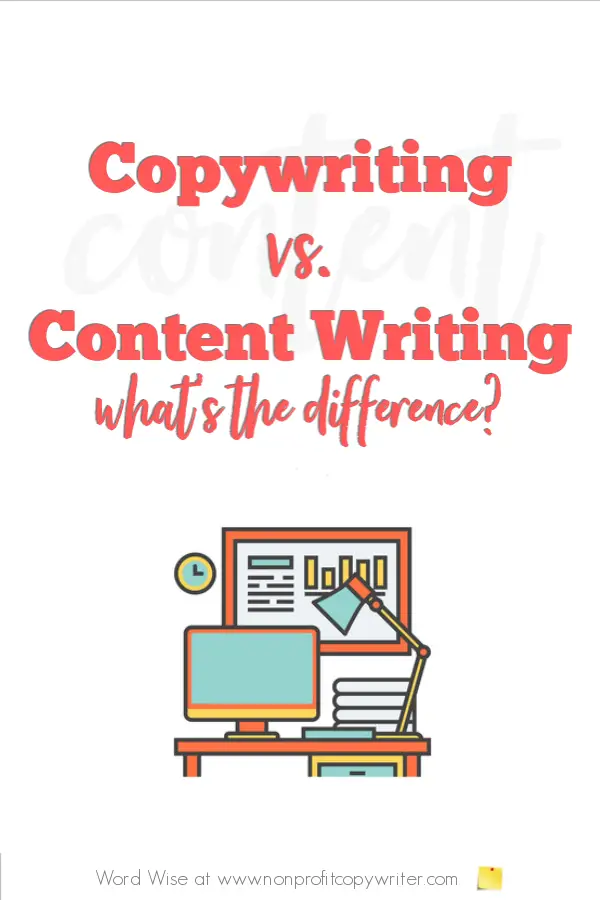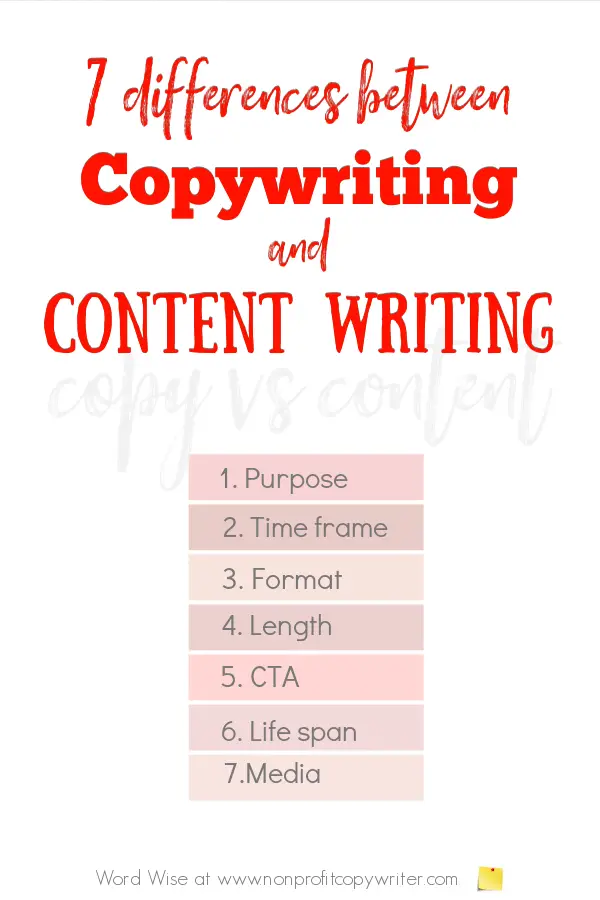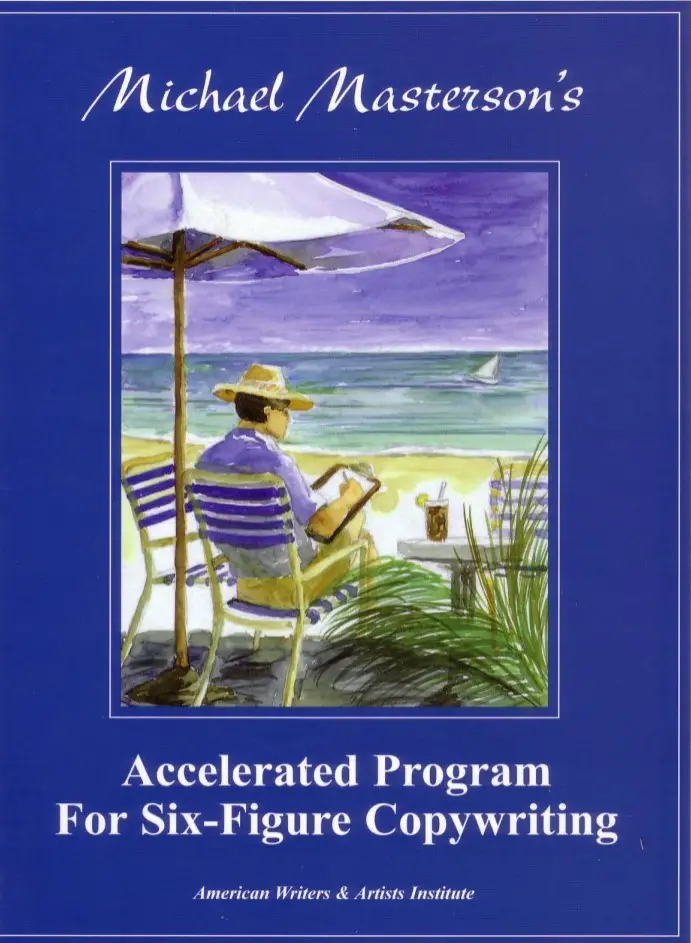Save Time: Get 5 Simple Writing Tips
you can put to use in 10 minutes
Copywriting vs Content Writing: What's the Difference?
Award-winning writer Kathy Widenhouse has helped hundreds of nonprofits and writers produce successful content , with 750K+ views for her writing tutorials. She is the author of 9 books. See more of Kathy’s content here.
Updated 11.25.25
Copywriting vs content writing: the terms are often used interchangeably. And to be honest, it’s taken me a while to figure out the differences between the two.
You’d think as a writer for more than a couple of decades, this would not be hard for me. And to be fair, both copywriting and content writing are forms of persuasive writing. Both use storytelling. Both draw on data to back up their claims.
But they’ve got some distinct differences, like …
1. Copywriting vs content writing: purpose
It is text that sells. The copywriter uses words persuade readers to take a specific action – more specifically, to purchase a product, buy a service, or give to a cause. In terms of persuasive mechanics, copywriting addresses a reader’s pain points or desires, using elements like urgency and a strong call to action to make the sale.
Content writing is relational.
It uses words to persuade readers with quality, relevant information to build a long-term relationship with the reader. Like copywriting, content addresses pain points, needs, and desires – but most often to help solve a problem for the reader so she will continue to read.
2. Copywriting vs content writing: time frame
Copywriting: immediate action
The purpose of a piece of copywriting is to persuade you to act right away: to buy, to click, to enroll, to volunteer, to download, to respond, to share, to subscribe to a service. Copywriting is inherently promotional and aims for immediate results. Its success is measured by its immediate results. Copywriting is about the short game – that is, getting the reader to act right now by addressing a single need or desire. It’s measured by response data.
Content writing: long term relationship
The purpose of a piece of content writing is to persuade you to engage over time: to return to the site, ask more questions, keep reading, desire ongoing support. Content writing is more about providing valuable information, entertainment, or education. It's not geared towards immediate conversions but rather focuses on brand building. Content success is measured over the long term. But it’s different from copywriting in that content writing is about the long game – that is, engaging your target reader repeatedly over time so she comes to trust you and be interested in your product or service. It’s measured by audience engagement, brand visibility, or SEO performance.
In both cases, the goal is persuasion. One does so quickly. The other, slowly.
3. Copywriting vs content writing: format
Because each has a different response time frame, copywriting and content writing projects are best suited to different formats.
Kinds of Copywriting Projects
Copywriting projects have a straightforward objective: get the reader to act immediately. Because of that urgency and focus, successful copywriting projects speak directly to one single need. How does your offer solve that one problem for the reader – and solve it now? This kind of persuasive writing is typical of sales pages, ads, direct mail, sales letters, sales emails, and appeal letters.
Kinds of Content Writing Projects
Content writing projects have a different objective – to cultivate a relationship with the reader so that when she is ready, she will act.
Relationships take time to build. Because of that, content writing pieces inform, entertain, and teach readers, preparing them to engage with a product or service. Bottom line: content writing projects provide value for the reader. They are are delivered in blogs, podcasts, email newsletters, autoresponders, books, e-books, articles, white papers, social media posts, case studies – even infographics.
Like copywriting, content writing projects speak directly to a reader’s needs, wants, and feelings and provides a way to solve the problem. The response can be now or later. (That’s why copywriting is considered to be a subset of content writing.)
The point is to build a long-term relationship. That’s why effective content writing is conversational and useful. You want your reader to come back over and over to your content. Yes, you’ll offer a call to action, which can be an invitation to readers to click, comment, respond, buy, give, opt in. But the key here is engagement.
4. Copywriting vs content writing: length
- Copywriting is concise and compelling. One look at the most favored formats for copy and you’ll notice that they’re on the short side: ads, taglines, and email campaigns, for example.
- Content writing embraces long form content. More space allows you to write conversationally gives you plenty of room for creativity and storytelling. Long form blog posts, for instance, run 1,500 words or more.
5. Copywriting vs content writing: CTA
In terms of mechanics, your copywriting project must have a clear call to action. A CTA prompts the audience to take a specific, often immediate, action, such as making a purchase, filling out a form, or clicking a link. Effective copywriting tells the reader exactly what to do to fix her “problem” and then makes it easy for her to do so.
While content may include CTAs, they are generally softer and aim to encourage further engagement or exploration rather than an immediate transaction.
6. Copywriting vs content writing: life span
Copywriting projects have a short shelf life. You’re writing to sell, right? Either you get the click or make the sale – or you don’t. So you routinely freshen up the sales pitch or sell another product altogether.
Content writing projects are evergreen. You write the piece of content and it can live for a long time online. By all means, update the content regularly. Add new images. Update the data. But the guts of content? It stays the same.
7. Copywriting vs content writing: media
Copywriting’s origin is print. The term "copywriting" originated from the practice of writing advertising copy – the text of an advertisement or promotional material – in the early 20th century when businesses began using advertising agencies to promote their products or services. Copywriting gained prominence with the growth of print media, including newspapers and magazines, along with the advent of radio scripts and subsequently television commercials.
When the internet came on the scene in the late 20th century and digital marketing transformed advertising, copywriting changed faces, too. Copywriters adapted their skills to suit online platforms, now including websites, email campaigns, and social media along with billboards and print ads and direct mail.
Content writing grew out of digital media. In the early 2000s, businesses began establishing an online presence. They needed written material to populate websites – that is, “textual content,” hence the term “content.” That included everything from informative articles and blog posts to product descriptions and other written material intended to engage and inform online audiences.
Today, content writing is an integral part of digital marketing strategies, and the demand for skilled content writers continues to grow. The term has become commonplace in job descriptions, freelance platforms, and educational programs related to writing and digital marketing.
Learn persuasive copywriting with this classic course.
Can you successfully be both a copywriter and a content writer?
Of course! Many successful writers seamlessly transition between copywriting and content writing. In fact, having skills in both areas can make a writer more versatile and adaptable to various projects and client needs. A good writer recognizes the specific requirements of each writing project and adjusts accordingly.
And while you may have the skills to be a generalist – that is, both a copywriter and a content writer, especially if you’re working for small businesses and organizations – today’s digital landscape allows writers to specialize. You may become a content writer for small veterinarians, for example. Or you may specialize in writing landing pages – a copywriting project – for vegetarian food bloggers.
- What copywriting expertise do you need to succeed? Joanna Wiebe, a leading conversion copywriter, emphasizes the importance of understanding the target audience's emotional triggers in copywriting. Persuasive copy taps into the audience's desires, pain points, and dreams to drive a desired action.
- What content writing expertise do you need to succeed? Ann Handley, a renowned content marketing expert, says the best content solves problems and provides value. Content writers should focus on creating valuable information that resonates with the audience. Doing so positions the biz as a reliable source of information.
Create your own content strategy with this fillable worksheet.
Which do you need most in a marketing strategy: copywriting or content writing?
Both!
A survey by the Direct Marketing Association revealed that well-crafted copywriting can boost conversion rates by up to 50%. Does persuasive writing drive immediate action? Yessir.
On the other hand, a study by Content Marketing Institute found that 60% of marketers create at least one piece of content per day. Doing so establishes consistency. Readers return to those online centers over and over because those creators have earned their trust.
When your content provides good information, you build an audience of followers. As you continually and consistently offer reliable, quality information that they need over time, you build trust with these followers. They recognize your credibility.
Ultimately, your content equips your readers to engage, to participate, to purchase, to give, to support, to volunteer, to become an advocate, or otherwise take action. So when it comes time for you to make the ask with a bit of copywriting, it’s easier for them to say yes.
More about Copywriting and Content Writing
Reach More Readers With Repurposed Content ...
The Skinny on Thin Content: Don’t Put Rankings Over Readers ...
How to Build a Content Writing Strategy for Your Blog or Website ...
How To Choose Content Topics for Your Content Calendar ...
7 Different Types of Content Writing You Need to Master ...
Kinds of writing projects copywriters do ...
Content Writing: General and Specific ...
What is Free Content and Why Should I Offer It?
More Tips for Writing Content on our Pinterest board ...
Return from Copywriting vs Content Writing to Nonprofit Copywriter home
As an Amazon Associate I earn from qualifying purchases.
Share This Page

Named to 2022 Writer's Digest list
BEST GENRE/NICHE WRITING WEBSITE


Stop Wasting Time!
Grab your exclusive FREE guide, "5 Simple Writing Tips You Can Put to Use in 10 Minutes or Less"















